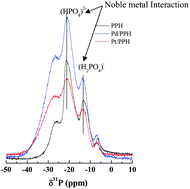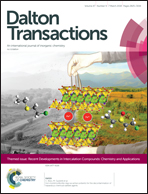Lamellar zirconium phosphates to host metals for catalytic purposes
Abstract
In the present study a porous lamellar zirconium phosphate heterostructure (PPH) formed from zirconium(IV) phosphate expanded with silica galleries (P/Zr molar ratio equal to 2 and (Si + Zr)/P equal to 3) was prepared to host noble metals. Textural and structural characterization of PPH-noble metal materials was carried out in order to elucidate the location and dispersion of the metallic particles and the properties of the resulting material to be used in catalytic processes. In the present paper, their activity in the catalytic hydrodeoxygenation (HDO) reaction of dibenzofuran (DBF) was evaluated. X-ray diffraction (XRD), solid state nuclear magnetic resonance (NMR) and X-ray photoelectron spectroscopy (XPS) evidenced that the structure of the pillared zirconium phosphate material was not modified by the incorporation of Pt and Pd. Moreover, transmission electron microscopy (TEM) showed a different dispersion of the noble metal. The acidity of the resulting PPH-noble metal materials also changed, although in all cases the acidity was of weak nature, and the incorporation of noble metals affected Brønsted acid sites as observed from 31P NMR spectra. In general, the textural, structural and acidic properties of the resulting materials suggest that PPH can be considered a good candidate to be used as a catalytic support. Thus, the catalytic results of the PPH-noble metal samples indicated that the Pd sample showed a stable behavior probably ascribed to a high dispersion of the active phase. However, the Pt sample suffered from fast deactivation. The selectivity to the reaction products was strongly dependent on the noble metal employed.

- This article is part of the themed collection: Recent Developments in Intercalation Compounds: Chemistry and Applications


 Please wait while we load your content...
Please wait while we load your content...